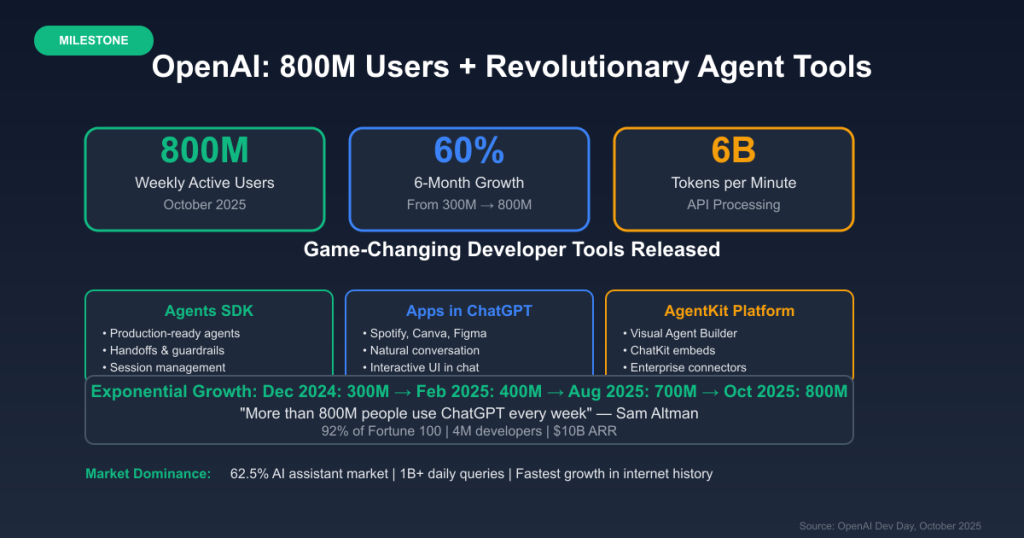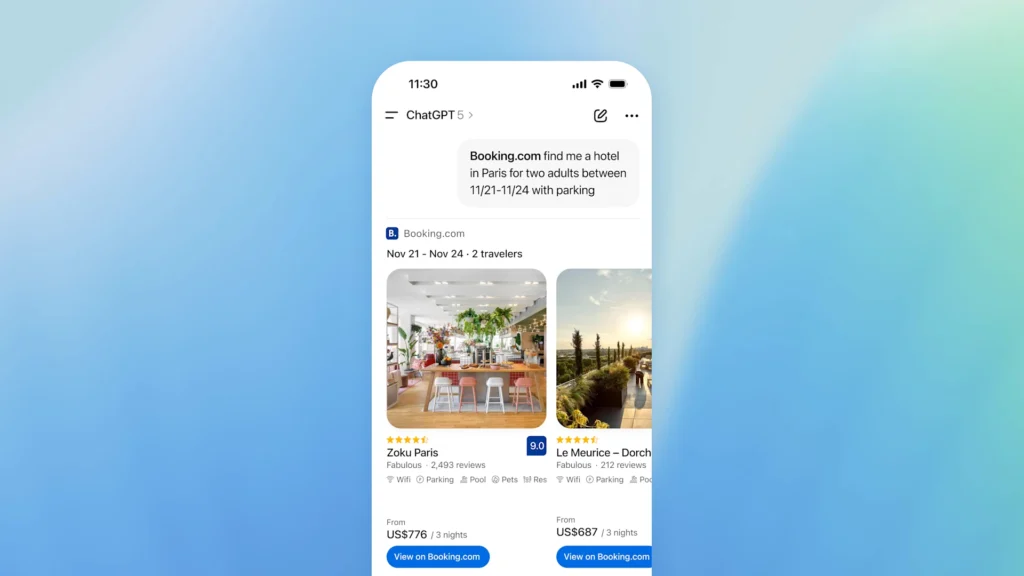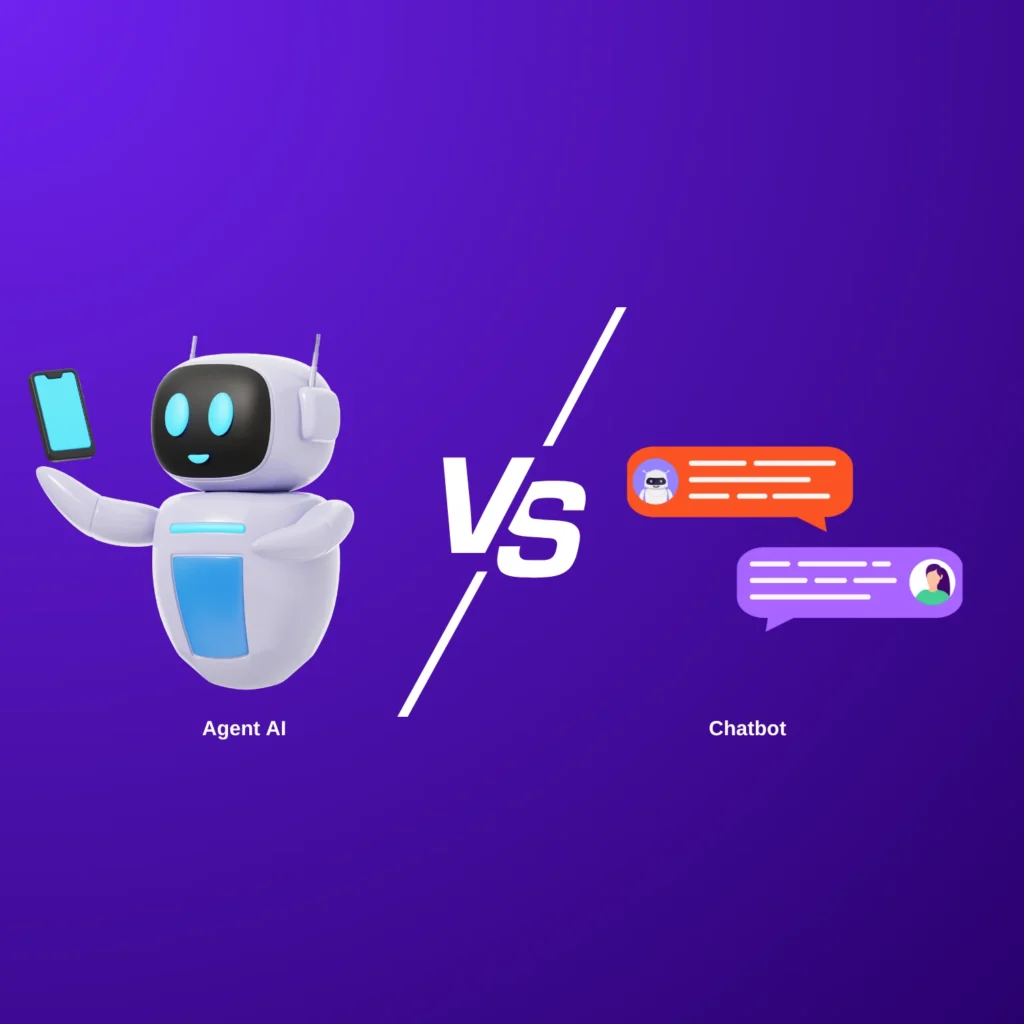The conversational AI landscape is undergoing a radical transformation. Gone are the days when chatbots were merely Q&A tools answering customer queries. Today, businesses demand AI-powered interfaces capable of executing meaningful actions, orchestrating multi-step workflows, and delivering context-aware, personalized experiences.With the launch of the ChatGPT Apps SDK, third-party brands can now integrate their products and services directly into ChatGPT conversations. From creating Spotify playlists to browsing Zillow property listings, or even purchasing products via Shopify Instant Checkout, these integrated chat experiences are shaping the next generation of AI-powered customer journeys.
Defining the Shift: What Exactly Are ChatGPT Apps?

OpenAI’s recent announcement has transformed ChatGPT from a conversational assistant into a dynamic platform integrating third-party applications. This evolution is powered by the new Apps SDK, enabling developers to embed interactive applications directly within ChatGPT conversations. This integration allows users to perform tasks such as designing graphics, creating playlists, and booking accommodations all within a seamless chat interface.
What Are ChatGPT Apps?
ChatGPT Apps are interactive applications built using OpenAI’s Apps SDK. These apps function within ChatGPT conversations, providing users with contextual assistance and enabling them to accomplish tasks without leaving the chat interface. For instance, users can request ChatGPT to design a poster using Canva or search for real estate listings on Zillow, with the respective applications integrated into the conversation.
The Apps SDK: A Developer’s Toolkit
The Apps SDK is a developer framework that allows the creation of applications running directly inside ChatGPT. It extends the Model Context Protocol (MCP), enabling developers to design both the logic and interface of their applications. This open-source framework ensures that applications built with the SDK can operate across various platforms that adopt this standard.
Currently, the SDK is available in preview, with plans for a broader rollout later this year, including app submissions and a user app directory.
Integrated Chat Applications: Enhancing User Experience
The integration of third-party applications within ChatGPT enhances user experience by providing a cohesive environment to interact with various services. Applications such as Booking.com, Canva, Coursera, Expedia, Figma, Spotify, and Zillow are now accessible directly within ChatGPT, allowing users to browse real estate listings, enroll in courses, or book rides seamlessly.
This integration streamlines workflows and enhances productivity by consolidating multiple services into a single conversational interface.
AI-Powered Customer Journeys: Personalizing User Interactions
AI-powered customer journeys leverage artificial intelligence to analyze user interactions and provide personalized experiences. Within ChatGPT, this means that as users engage with integrated applications, the AI can offer tailored recommendations and assistance based on their preferences and behaviors.
For example, while planning a trip, ChatGPT can suggest destinations, accommodations, and activities by analyzing the user’s past interactions and preferences, thereby creating a customized travel experience.
Several top-tier brands are pioneering this model:

- Spotify – Users can ask ChatGPT to generate playlists or discover new music, with results delivered directly in the conversation, without opening the Spotify app.
- Canva – Marketers and creatives can generate presentations, social media assets, and posters on-demand, directly through ChatGPT’s interface.
- Zapier – Enables workflow automation, connecting tools like Gmail, Slack, and Trello to automate multi-step processes inside conversations.
- Instacart – Users can search for recipes and instantly add ingredients to their carts, demonstrating the power of AI-driven commerce inside chat.
- Zillow & Home Depot – Property searches and home improvement planning tools appear interactively, allowing users to explore, calculate, and plan without leaving ChatGPT.
Recent announcements also highlight Instant Checkout capabilities, enabling users to complete end-to-end transactions directly inside ChatGPT. This leverages the Agentic Commerce Protocol, allowing brands to offer product discovery, customization, and payment flows within the chat experience—effectively creating a seamless AI-native shopping journey.

The Concept Behind ChatGPT Apps: The Power of Microbots
When ChatGPT was introduced to the world, it just didn’t fit into the concept of an app. It redefined what an app could be. It became a dynamic assistant capable of engaging in meaningful conversations, problem-solving, and even offering creative insights.
This shift changed the definition of an application. What once was a tool to complete specific functions is now evolving into a conversational partner that can adapt, learn, and provide personalized support. This transformation is a key part of the ongoing revolution in conversational AI as we move from apps that simply serve a purpose to those that interact and assist users in ways that were previously unimaginable.
The rise of ChatGPT Apps is closely connected to the power of microbots. An AI agent performs a single task in isolation, a microbot is a collection of specialized AI agents working together within a conversational interface. While one agent might handle a flight booking and another manages payments, a microbot orchestrates multiple agents to execute multi-step tasks seamlessly within a chat.
Understanding Microbots
In the evolving world of conversational AI, microbots act as specialized teams of AI agents working together to handle complex tasks. Think of them like a team of experts in the hospital scenario:
- A cardiologist focuses on heart issues
- A radiologist interprets scans
- A surgeon performs operations
Similarly, in a ChatGPT-powered conversational interface:
- A scheduling agent manages calendars and appointments
- A support agent handles returns, FAQs, and customer queries
- A commerce agent facilitates purchases, payments, and product recommendations
By orchestrating multiple agents, businesses can modularize AI functionality, enabling multi-step workflows that are seamless and efficient.
Benefits of Microbots
Scalable Automation: Organizations can easily deploy additional agents to automate new tasks as business needs grow, enabling flexible and efficient workflows.
Seamless Integration: Users can interact with multiple agents across the platform without switching between apps, creating a smooth and unified experience.
Reduced Complexity: Developers and enterprises can focus on building specialized, task-specific agents instead of managing a single large system.
Why This Matters for Businesses: Beyond ChatGPT Apps
The rise of microbots signals a transformative shift in how businesses interact with customers and manage internal workflows. These specialized AI agents are no longer limited to answering queries. They execute tasks, orchestrate processes, and deliver personalized experiences, creating a new standard in enterprise AI adoption.
Streamlined Workflows
Modern organizations often operate across multiple systems, platforms, and communication channels. Microbots bring these processes together, allowing complex workflows to be completed within a single, intelligent interface.
For example, a customer support workflow could involve:
- Checking the status of an order
- Initiating a return
- Generating shipping labels
Rather than handling each step separately, a microbot orchestrates multiple agents to manage the entire workflow automatically, reducing friction and accelerating resolution times.
Internally, enterprises can deploy workflow automation with microbots for HR requests, IT ticketing, and finance approvals. Each microbot specializes in its task.
Hyper-Personalization
Consumers and employees increasingly expect experiences tailored to their needs. Microbots can track user interactions, preferences, and prior behavior to deliver personalized AI conversations that guide users efficiently through tasks.
For instance:
- A support agent offers solutions based on past issues
- A commerce agent recommends products aligned with previous purchases
- A scheduling agent optimizes meeting arrangements based on calendar context
By delivering personalized, actionable recommendations, businesses can increase engagement, satisfaction, and loyalty.
Operational Efficiency
Microbot orchestration allows multi-step processes to run seamlessly across multiple specialized AI agents, reducing manual intervention and human error. This enables organizations to:
- Automate repetitive tasks
- Accelerate response times
- Scale operations efficiently as demand grows
The result is AI-powered customer journeys that are faster, more reliable, and consistent across touchpoints.
A New Standard in Business Interactions
The adoption of microbots is redefining enterprise operations. By modularizing AI functionality into specialized agents, businesses can orchestrate task-oriented microbots to manage complex workflows across departments.
This approach delivers context-aware, actionable, and personalized interactions, setting a new benchmark for enterprise conversational AI solutions. It goes beyond simple chat responses. AI is now embedded into the workflow itself, enabling businesses to transform customer and employee experiences at scale.
Designing for the Future: Principles of Conversational Workflows
To fully leverage microbots, enterprises must rethink conversation design.
1. Context is King
A microbot may involve multiple agents performing different tasks. One handling scheduling, another managing payments, and yet another delivering support. Maintaining context across all these agents is critical to ensure seamless interactions.
For example, in a customer support scenario:
- The first agent retrieves order details
- The second agent initiates a return
- The third agent generates a shipping label
Without maintaining context, the user would need to repeat information at each step, breaking the flow and reducing efficiency. Context-aware conversational workflows allow microbots to remember user inputs, preferences, and previous actions, resulting in smooth, personalized AI-driven experiences.
2. Design for Action
Conversations in modern enterprises should do more than provide information. They should complete tasks efficiently. A single AI agent may answer a question, but it’s the microbot orchestration that executes multi-step tasks within a single interface.
For instance:
- A commerce microbot not only suggests products but also applies discounts, processes payment, and schedules delivery
- A scheduling microbot automatically checks calendars, proposes options, and confirms appointments
Designing for action transforms chat from a passive communication channel into a proactive, task-oriented tool that drives operational efficiency.
3. Orchestration Over Isolation
Individual AI agents are powerful, but their real strength emerges when they operate together as a microbot. Orchestration ensures that multiple agents work in harmony, delivering multi-step workflows without confusing the user.
Consider an enterprise onboarding workflow:
- Agent 1 collects employee details
- Agent 2 sets up IT accounts and access
- Agent 3 schedules orientation sessions
By orchestrating these agents within a single conversational interface, microbots reduce complexity, minimize manual handoffs, and create a cohesive experience for users.
Designing with Microbots in Mind
The future of conversational AI lies in modular, task-specific agents operating collaboratively. Businesses that adopt microbot-centric design principles maintaining context, designing for action, and orchestrating workflows:
- Seamless, real-time interactions for customers and employees
- Automated multi-step processes that save time and resources
- Personalized, context-aware experiences that drive engagement and satisfaction
By treating each microbot as a miniature AI ecosystem, enterprises can scale conversational solutions across departments and use cases, unlocking the full potential of AI-powered customer journeys.
Applications and Use Cases
The power of real-time conversational apps lies in their ability to orchestrate multiple AI agents within a single interface, creating a microbot that can handle complex, multi-step tasks seamlessly. These integrated chat apps are transforming industries by delivering AI-driven customer support, automating workflows, and enhancing enterprise productivity.
E-Commerce
In modern retail, a commerce microbot can manage inventory checks, provide personalized product recommendations, and facilitate purchases all within a single conversation. By combining multiple specialized AI agents, businesses can create real-time conversational apps that guide customers from discovery to checkout without leaving the chat interface. This seamless approach enhances engagement, reduces friction, and drives higher conversion rates.
Customer Support
Customer service is another area where integrated chat apps powered by microbots excel. A support microbot can handle returns, perform policy checks, generate shipping labels, and even escalate complex issues all orchestrated through multiple AI agents working together. This AI-driven customer support reduces response times, improves accuracy, and ensures a consistent, context-aware experience for users.
Enterprise Productivity
Microbots are not limited to customer-facing interactions. They are revolutionizing internal enterprise workflows as well. HR requests, scheduling, approvals, and IT ticketing can be managed by specialized agents within a single microbot, creating real-time conversational apps that automate routine tasks and streamline processes. By deploying integrated chat apps for internal operations, organizations can boost productivity, minimize manual errors, and free human resources for more strategic work.
Automotive
In the automotive sector, conversational microbots are streamlining the entire customer journey from exploring car models and checking availability to scheduling test drives and applying for financing. A single microbot can orchestrate multiple agents to provide real-time responses, personalize recommendations based on user preferences, and automate complex processes like service booking or insurance renewals. This creates a real-time conversational app experience that significantly enhances customer engagement.
BFSI
For BFSI companies, microbots are transforming customer support and internal operations. Agents within a single microbot can assist with account management, loan applications, policy renewals, fraud detection alerts, and transaction processing. By deploying integrated chat apps powered by AI-driven customer support, banks and insurance firms can deliver personalized AI conversations, reduce operational bottlenecks, and improve service efficiency ultimately elevating customer satisfaction.
The Future of Conversational AI
The future of conversational AI is rapidly moving toward a paradigm where conversations become the primary user interface for digital interactions. Rather than relying on traditional apps or websites, users will engage with real-time conversational apps powered by AI-powered workflows that can orchestrate complex tasks.
We can expect the rise of microbots, enabling businesses to plug in specialized AI agents into integrated interfaces without reinventing the wheel. These ecosystems will allow enterprises to automate multi-step workflows while maintaining context and personalization throughout the customer or employee journey.
The future of conversational AI will be defined by integrated, intelligent, and task-oriented experiences, where businesses can deploy microbots to drive efficiency, personalization, and measurable impact across every interaction.
Conclusion: A New Paradigm for Interaction
By combining specialized AI agents into task-oriented microbots, enterprises can orchestrate multi-step workflows that are seamless, context-aware, and highly personalized. This represents a fundamental shift from simple question-and-answer chat interfaces to integrated conversational experiences. This shit is capable of driving operational efficiency, enhancing customer satisfaction, and enabling AI-powered customer journeys.
As organizations embrace conversational workflow automation, they unlock new levels of productivity across industries from e-commerce and automotive to BFSI and enterprise operations. Real-time, intelligent interactions allow businesses to deliver personalized AI conversations, streamline internal processes, and provide AI-driven customer support that adapts dynamically to each user’s needs.
At DaveAI, we are building for this future. The future of conversational AI is unfolding in a way where interactions don’t just inform, they act, anticipate, and simplify workflows. Both DaveAI and ChatGPT share this vision of AI automating tasks within apps, and at DaveAI, we bring it to life by developing microbots that intelligently handle actions behind the scenes. This approach transforms interactions into seamless, context-aware experiences, hinting at the next evolution in how users engage with applications. Explore how this technology can enhance your customer journeys and position your organization at the forefront of the evolving conversational AI landscape.



